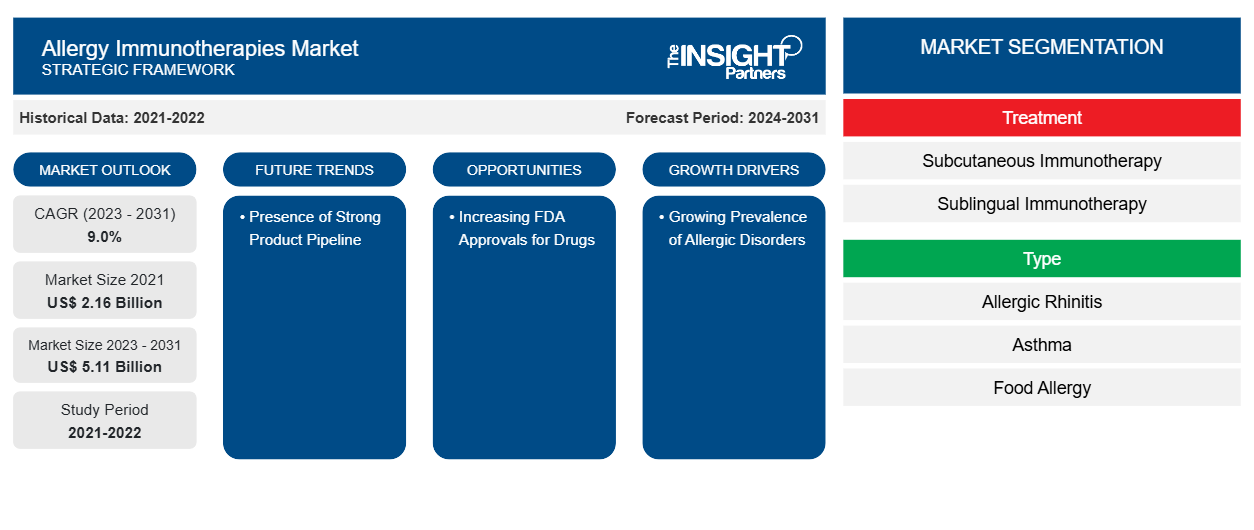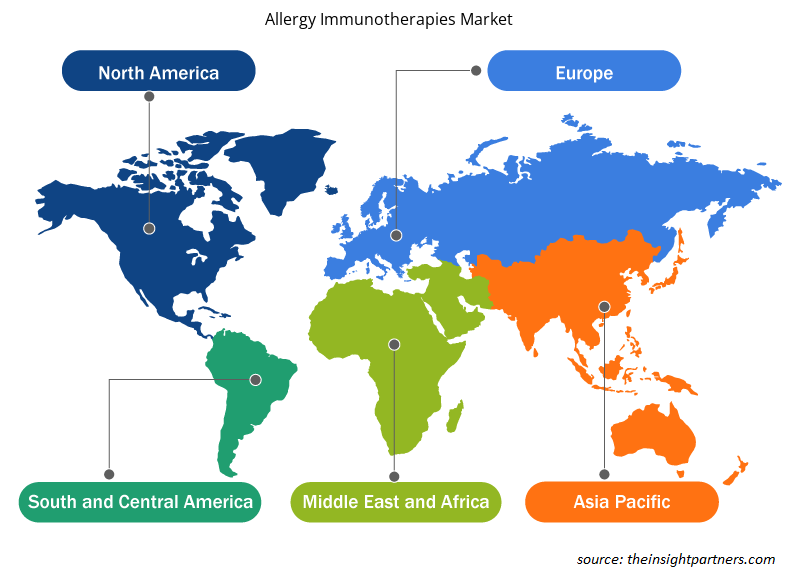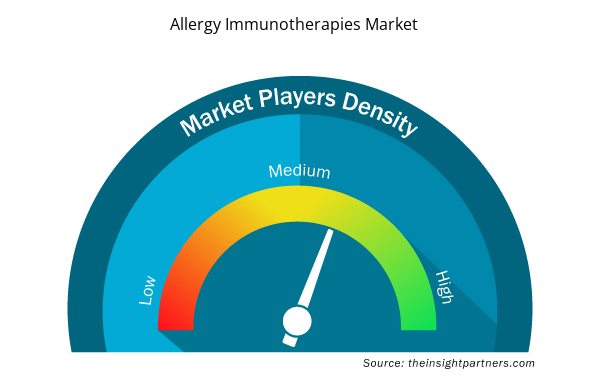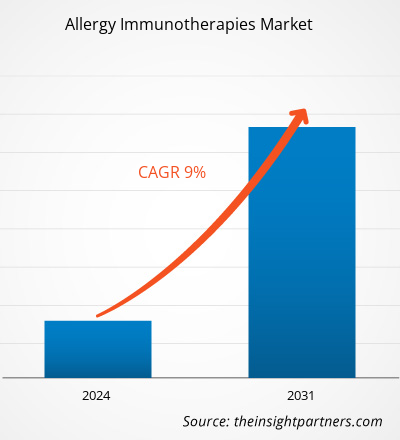The allergy immunotherapies market was estimated to be US$ 2.16 Bn in 2021 and US$ xx Bn in 2023. It is expected to reach US$ 5.11 Bn by 2031 and record a CAGR of 9.0% until 2031. Development of new delivery methods, rise of combination therapies, advancements in personalised medicine will likely remain key allergy immunotherapies market trends.
Allergy Immunotherapies Market Analysis
Increasing prevalence of allergic disorders worldwide is expected to drive the allergy immunotherapies market's growth. The growing prevalence of allergic disorders demands allergy immunotherapy, which is a safe and effective treatment against allergens such as insect molds, pollen, and animals, as well as for allergic asthma. As per the American College of Allergy, Asthma & Immunology, in 2021, 1 in 3 adults and over 1 in 4 children in the US have reported having a seasonal allergy, eczema or food allergy.
The growing prevalence of allergies across the globe is raising the global demand for immunotherapies, which favors the growth of the market.
Allergy Immunotherapies Market Overview
The global allergy immunotherapies market is segmented by region into North America, Europe, Asia Pacific, Middle East & Africa, and South & Central America. The market growth in this region is expected due to factors such as the increasing prevalence of allergic disorders and technological advancements in sublingual dosage formulations. However, drawbacks associated with the use of allergy immunotherapies and regulatory variations across regions are likely to hamper the market growth during the forecast period.
Customize This Report To Suit Your Requirement
You will get customization on any report - free of charge - including parts of this report, or country-level analysis, Excel Data pack, as well as avail great offers and discounts for start-ups & universities
Allergy Immunotherapies Market: Strategic Insights

- Get Top Key Market Trends of this report.This FREE sample will include data analysis, ranging from market trends to estimates and forecasts.
You will get customization on any report - free of charge - including parts of this report, or country-level analysis, Excel Data pack, as well as avail great offers and discounts for start-ups & universities
Allergy Immunotherapies Market: Strategic Insights

- Get Top Key Market Trends of this report.This FREE sample will include data analysis, ranging from market trends to estimates and forecasts.
Allergy Immunotherapies Market Drivers and Opportunities
Growing Awareness of Allergy Treatment is Likely to Favor The Market.
Increased public awareness about allergies and their management options fuels demand for better treatments. People seek relief from symptoms that can significantly impact their quality of life.
The Office of the State Superintendent of Education (OSSE) and the Division of Health & Wellness celebrated Food Allergy Awareness Week from May 14 to May 20, 2023. The campaign focused on educating and raising awareness about food allergies and anaphylaxis.
Presence of Strong Product Pipeline – An Opportunity in Allergy Immunotherapies Market
The allergy immunotherapy pipeline consists of 15 therapies in different clinical stages of development. Some of the players involved in the development of immunotherapies for allergic diseases are Aimmune Therapeutics Inc., DBV Technologies S.A., Genentech Inc., ASIT biotech SA, Inmunotek SL, Anergis S.A., Biomay AG, and Regeneron Pharmaceuticals Inc.
Positive clinical results of various immunotherapies undergoing clinical trials support the development of allergy immunotherapy-based drugs. For instance, in November 2022, the Food and Drug Administration (FDA) granted Fast Track designation to Alladapt Immunotherapeutic’s ADP101- an investigational oral immunotherapy for treating one or more of the most significant food allergens
Allergy Immunotherapies Market Report Segmentation Analysis
Key segments that contributed to the allergy immunotherapies market analysis derivation are services and applications.
- Based on treatment, the allergy immunotherapies market is segmented into subcutaneous immunotherapy (SCIT) and sublingual immunotherapy (SLIT). In 2023, the subcutaneous immunotherapy (SCIT) segment held the largest share of the market. Moreover, the sublingual immunotherapy (SLIT) segment is expected to grow at the fastest rate during the forecast period.
- By allergy type, allergy immunotherapies market is segmented into allergic rhinitis, asthma, food allergy, venom allergy, and others. The allergic rhinitis segment held the largest share of the market in 2023, and the same segment is anticipated to register the highest CAGR in the market during the forecast period.
- The allergy immunotherapies market has been segmented by distribution channel into hospital pharmacy, retail pharmacy, and online pharmacy. In 2023, the hospital pharmacy settings segment held the largest share of the market by distribution channel. Moreover, the same segment is expected to grow fastest during the forecast period.
Allergy Immunotherapies Market Share Analysis by Geography
The geographic scope of the allergy immunotherapies market report is mainly divided into five regions: North America, Asia Pacific, Europe, Middle East & Africa, and South America/South & Central America.
North America includes US, Canada, and Mexico. North America holds the most significant share in the allergy immunotherapies market, with the US holding the largest market share, followed by Canada. The US holds the largest share of the allergy immunotherapies market attributed to the growing prevalence of allergic disorders, thereby increasing the demand for allergy immunotherapy and fueling the market's growth. Moreover, it is headquarters for many manufacturers engaged in the manufacturing of allergy immunotherapy, further driving the growth of the market in the country. Moreover, rising consumer awareness regarding allergy treatment has increased demand for health supplemental oxygen in North America.
Asia Pacific region is expected to be the fastest-growing region among all other regions. The growth of the market in the Asia Pacific region is expected to grow at a faster pace owing to factors such as the high prevalence of allergic and immunology diseases in countries such as Australia, India, and others. Furthermore, increasing initiatives adopted by the government in terms of prevention and treatment strategies are expected to provide a lucrative market growth scenario in the region. Additionally, developing healthcare infrastructure and increasing investments to boost research activities are projected to drive the Asia Pacific Allergy Immunotherapies Market during the forecast period.
Allergy Immunotherapies Allergy Immunotherapies Market Regional Insights
The regional trends and factors influencing the Allergy Immunotherapies Market throughout the forecast period have been thoroughly explained by the analysts at Insight Partners. This section also discusses Allergy Immunotherapies Market segments and geography across North America, Europe, Asia Pacific, Middle East and Africa, and South and Central America.

- Get the Regional Specific Data for Allergy Immunotherapies Market
Allergy Immunotherapies Market Report Scope
| Report Attribute | Details |
|---|---|
| Market size in 2021 | US$ 2.16 Billion |
| Market Size by 2031 | US$ 5.11 Billion |
| Global CAGR (2023 - 2031) | 9.0% |
| Historical Data | 2021-2022 |
| Forecast period | 2024-2031 |
| Segments Covered |
By Treatment
|
| Regions and Countries Covered | North America
|
| Market leaders and key company profiles |
Allergy Immunotherapies Market Players Density: Understanding Its Impact on Business Dynamics
The Allergy Immunotherapies Market is growing rapidly, driven by increasing end-user demand due to factors such as evolving consumer preferences, technological advancements, and greater awareness of the product's benefits. As demand rises, businesses are expanding their offerings, innovating to meet consumer needs, and capitalizing on emerging trends, which further fuels market growth.
Market players density refers to the distribution of firms or companies operating within a particular market or industry. It indicates how many competitors (market players) are present in a given market space relative to its size or total market value.
Major Companies operating in the Allergy Immunotherapies Market are:
- ALK-Abelló A/S
- Nestlé Health Science
- LETIPharma
- Stallergenes Greer
- HAL Allergy B.V.
- Johnson and Johnson Services, Inc.
Disclaimer: The companies listed above are not ranked in any particular order.

- Get the Allergy Immunotherapies Market top key players overview
Allergy Immunotherapies Market News and Recent Developments
The allergy immunotherapies market is evaluated by gathering qualitative and quantitative data post primary and secondary research, which includes important corporate publications, association data, and databases. The following is a list of developments in the market for allergy immunotherapies and strategies:
- In August 2020, Nestlé Health Science acquired Aimmune Therapeutics. Aimmune's approved therapy Palforzia would expand Nestlé Health Science portfolio with first and only FDA-approved treatment to help reduce the frequency and severity of allergic reactions to peanuts in children. (Source: Company Press Release)
- In September 2023, Stallergenes Greer entered into an agreement with Nestlé Health Science to harness the peanut allergy oral immunotherapy treatment Palforzia. (Source: Company Press Release)
Allergy Immunotherapies Market Report Coverage and Deliverables
The “Allergy Immunotherapies Market Size and Forecast (2021–2031)” report provides a detailed analysis of the market covering below areas:
- Market size and forecast at global, regional, and country levels for all the key market segments covered under the scope
- Market dynamics such as drivers, restraints, and key opportunities
- Key future trends
- Detailed PEST/Porter’s Five Forces and SWOT analysis
- Global and regional market analysis covering key market trends, major players, regulations, and recent market developments
- Industry landscape and competition analysis covering market concentration, heat map analysis, prominent players, and recent developments
- Detailed company profiles
- Historical Analysis (2 Years), Base Year, Forecast (7 Years) with CAGR
- PEST and SWOT Analysis
- Market Size Value / Volume - Global, Regional, Country
- Industry and Competitive Landscape
- Excel Dataset



Report Coverage
Revenue forecast, Company Analysis, Industry landscape, Growth factors, and Trends

Segment Covered
Treatment ; Allergy Type ; Distribution Channel , and Geography

Regional Scope
North America, Europe, Asia Pacific, Middle East & Africa, South & Central America

Country Scope
Argentina, Australia, Brazil, Canada, China, France, Germany, India, Italy, Japan, Mexico, Saudi Arabia, South Africa, South Korea, Spain, United Arab Emirates, United Kingdom, United States

 Get Free Sample For
Get Free Sample For